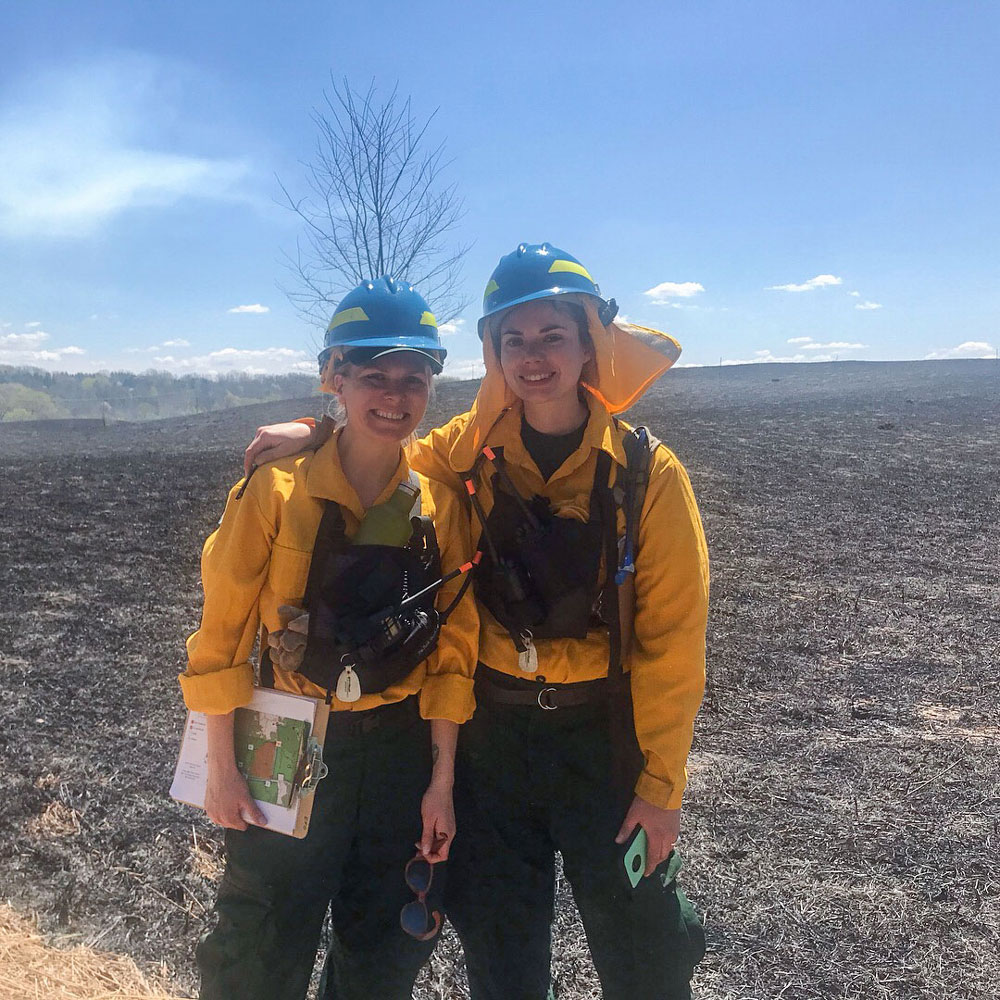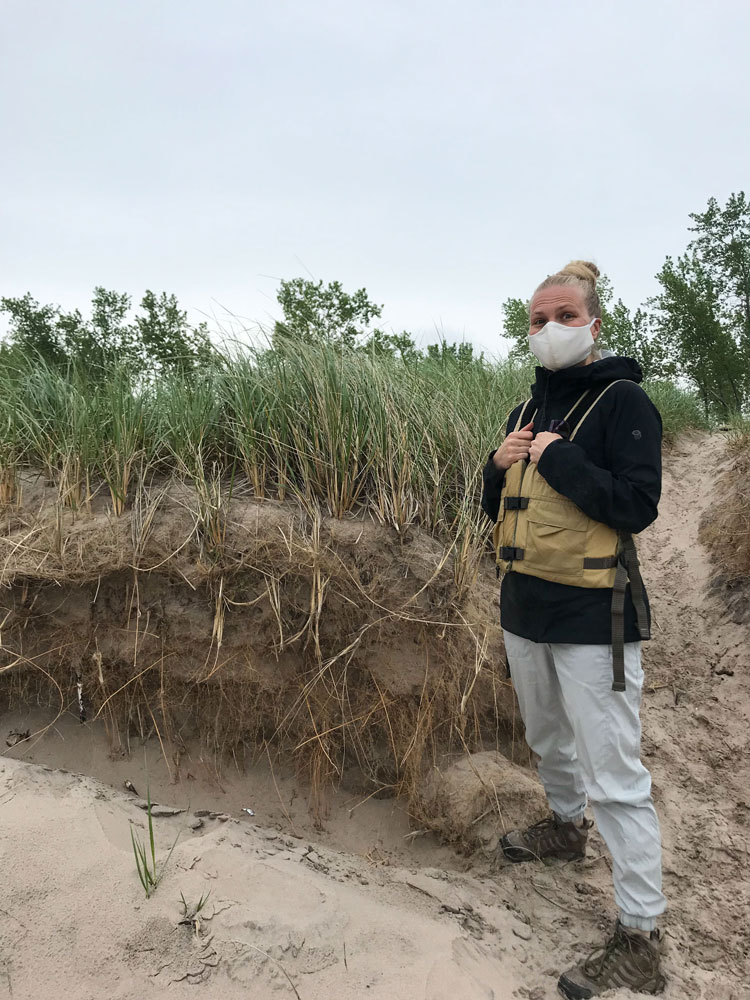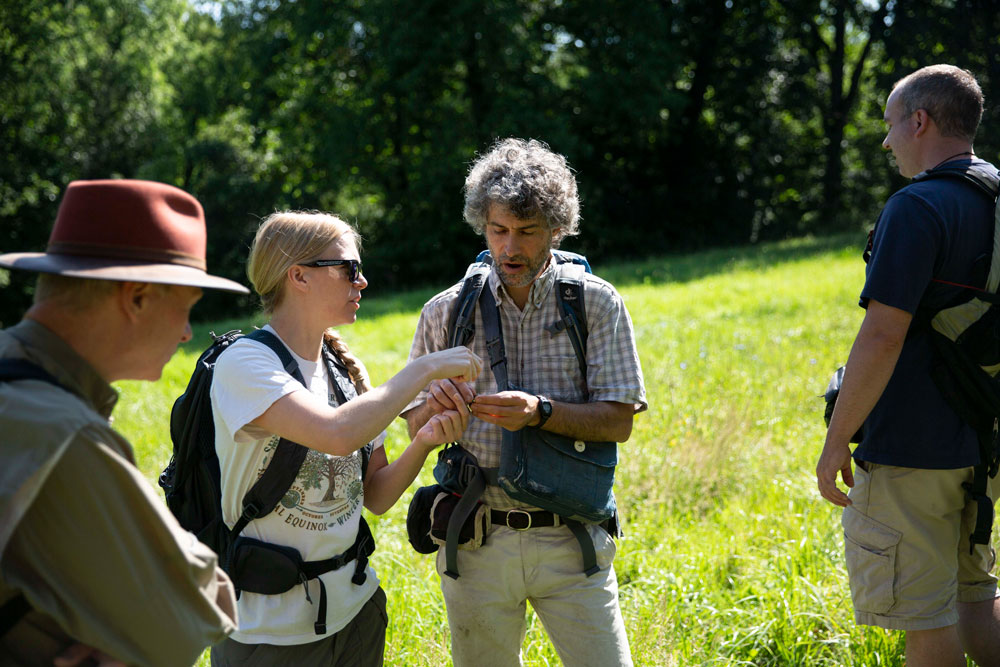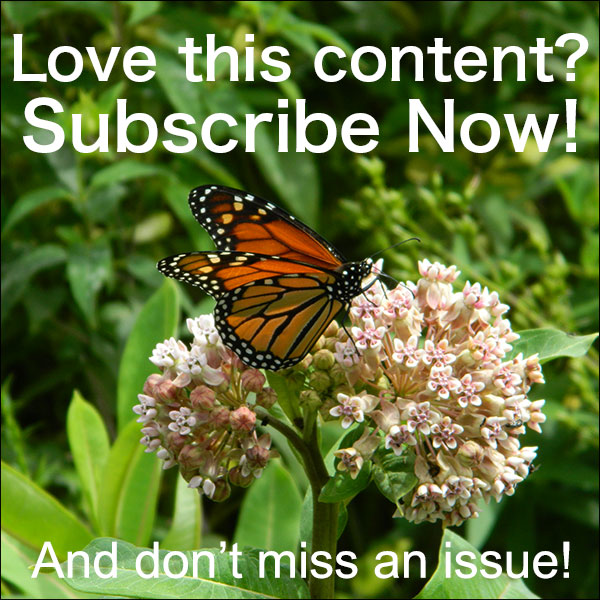By Kimberly Burkard
On a chilly but beautiful early May day I had the opportunity to sit and talk with Whitney Carleton, Biologist for New York State Parks’ Finger Lakes Environmental Field Team. As we sat in a sunny nook of an outdoor seating area at a local coffee shop, we saw and heard the signs of spring all around us—the trees with their colorful blooms, the honk of Canada geese flying overhead, songbirds singing joyful songs, and the springtime exuberance of all the other plants around us surging to life after the winter cold. We spoke of many things but mostly about how Whitney came to be a key player in New York State’s effort to preserve and foster our natural heritage as well as how anyone can join in those efforts at home.
Like most true callings, the path that Whitney took to get to where she is today is not the one she expected. While at grad school, SUNY College of Environmental Science and Forestry (ESF), Whitney learned about and took part in a NY State Parks volunteering opportunity to help teach kids about environmental principals at Green Lakes State Park. While there, she connected with some individuals from NY State Parks that were interested in her background with wetlands and prairies as they had been trying to conduct a prescribed burn* in the Ganondagan State Historic Site’s grasslands area for years as well as a large-scale wetland restoration project in the region. Whitney was hired in 2013 to manage these projects. The trial position was planned to span only few months but proved valuable enough that years later she is still actively working on conservation and restoration projects with the agency.

Those initial Ganondagan activities helped to grow key conservation resources for NY State Parks such as the Finger Lakes Environmental Field Team (FL EFT) and the Plant Materials Program**, which employ up to 20 staff in the heart of the summer. Whitney currently oversees the FL EFT whose mission is to aid the Finger Lakes region in meeting its commitment to responsible stewardship of State Parks by focusing on projects that conserve rare/threatened species and natural communities, to restore and enhance habitats and natural communities, and to engage with other Parks staff to incorporate stewardship and environmental planning. Just like everywhere else, COVID has brought changes to her workplace. There was a restructuring that combined the FL EFT group with those of the Central (Syracuse) and the 1000 Islands Regions into a new district. Ms. Carleton sees the Finger Lakes staff, which is the largest of the three, working with these other regions on projects and sharing both capacity and expertise with them. She also sees that there will be an expansion of an in-house Hemlock preservation program (see below) throughout their district as the Central region is now the geographic leading edge of Hemlock Woolly Adelgid infestation so there will be much critical activity concerning hemlock preservation there.

And as a whole, New York State Parks is serious in its commitment to native NY species. It has a policy to use New York State native plants in their park plantings with exceptions of historical plantings and specific landscaping needs. The Plant Materials Program is key here. Unlike commercial nurseries, they sustainably collect seed from project sites to grow so the plants returning to that site have the appropriate genetics to be best adapted. It may be new to many home gardeners, but subspecies and the specific strains really do make a difference to the ecosystems they are put in. This becomes increasingly important when less common, or even rare, plants are needed for a planting. The Plant Materials Program can and does supply the proper strains of a given species. Building off of previous work of partners, they have developed procedures for sustainable seed collection practices—and are ready to help others in learning those procedures. The Plant Materials Program already serves seven regions in the state and staff are hopeful their capacity will continue to grow and provide for more projects within NY State Parks.
Early projects, such as Ganondagan, taught the FL EFT much in how to approach their conservation efforts and they are now looking at the whole region to determine where and what activities are in the most need of their services—which according to Whitney, focuses largely on preservation rather than restoration as preservation work requires much less effort and creates a more substantial environmental impact. Some of their current preservation work includes:
• A region-wide Eastern Hemlock program which is part of a statewide Hemlock Conservation Program initiative. Their program focuses on preserving hemlocks in all gorge State Parks against the non-native insect, Hemlock Woolly Adelgid, which is killing hemlock trees. Those park gorges are lined with unique hemlock forest ecosystems that exist only because of those trees. These efforts will preserve the trees from destruction thereby preserving those forests which in turn will keep cooler stream temperatures for animals like brook trout, maintain water quality by managing storm water runoff, and help to prevent harmful algal blooms in the long run.
• The large-scale grassland project at Ganondagan, which includes not only the 2 parcels planted in 2008 but also over 200 acres of grassland in other areas that have been converted from crop land or pastures to warm-season grasslands. Areas that are now almost entirely populated with NYS plant species. Historical texts of visitors to Seneca villages, reference ecosystems, and scientific research via partners were helpful in determining what species belonged in these areas. Some of this newer grassland restoration area has progressed well enough that this year that it too can be managed with a prescribed burn. This work has fostered more abundance and diversity in small mammals and rare bird species at the site and has helped to make almost all of the Ganondagan State Historic Site a Bird Conservation Area, the first in the Finger Lakes region.

• Three Gorges Project centers the stream areas of Taughannock Falls, Robert H. Treman, and Buttermilk Falls State Parks and the project work includes removing invasive species, monitoring the tree canopy (hemlock), doing invertebrate surveys, and planting in riparian/upland areas—in other words, actively addressing every level of these stream environments. Through successive years they have created a restoration buffer around the stream zones and have dramatically improved the health of these zones as well as downstream areas.
• Partnering in American Beach Grass research with SUNY ESF plant genetic scientists on this plant used to prevent beach erosion. The goal is to identify the Great Lakes strain of the grass and to propagate it via the Plant Materials Program because aggressive or cultivated varieties are all that is now commercially available. They will make use of this grass at Fair Haven Beach State Park and in the 1000 Island areas.
To the extent possible plants and seed for the projects noted are provided by the Plant Materials Program.
“A rising tide lifts all boats,” said Whitney in reference to the information and expertise that she and all the members of her team share widely for their hope and passion is that everyone can lend a helping hand in the preservation of the natural beauty and life of our great state. She continued, “It is so doable for yourself, too. And I don’t think people consider conservation or restoration projects something they can do at home. You don’t think about the fact that your backyard was once one of these spaces too. You can make an inviting space for nature in your own backyard.”
In her free time Whitney is on the Steering Committee for the Finger Lakes Native Plant Society and Finger Lakes Partnership for Regional Invasive Species Management. She lends help and botanical advice to local organizations or small business owners whenever possible, and runs a passion project called In Situ Designs NY to give people in the Greater Rochester area DIY knowledge for landscaping with conservation in mind. Below are some tools Whitney suggests for learning more and making a difference in your neighborhood.

Learn More & Make a Difference
• New York Natural Heritage Program, www.nynhp.org
Many natural resources including citizen science programs to take part in and Community Conservation Guides that help home owners to better understand the natural habitats and key species that may still exist on their property and around it. Even fostering the couple of native species that are flourishing at your home can make an impact.
• New York Flora Atlas, newyork.plantatlas.usf.edu
This is the ultimate of all online resources for NY’ers to check the NYS native status of any plant. All search listings have a column with a simple “yes” or “no” for the plant’s native status in NY State. This is critical as not all plants marked “native” at your local nurseries are native to NY. Bookmark this website and look up the plants you find before purchasing, even on your phone as you shop!
• Look for and ASK for the straight native species
These plants can be challenging to find but are worth it as they have the best ecological impact. These are the native plants of wild types and with wild ancestors. Cultivars of native plants, especially those that substantially alter the plant—double blooms, other colors, etc., are plants that have never grown in the wild and are not proven to offer the same value to local fauna. If you don’t find the straight species, ask your nurseries for them. Nurseries need to understand that there is a desire, need, and market for these plants or they will have no reason to stock them.
• Finger Lakes Native Plant Society, flnps.org
Events and activities about native plants. Also look for recorded past talks on the website. If you like a challenge, look for their March 2021 program on the Rare Plant Watch List for the Finger Lakes. Perhaps you can spot some of these rarities and alert the Natural Heritage Program to their existence.
• Writings and Talks of Doug Tallamy
Having trouble getting started or need easier information? Look for the writings of and recorded various speaking engagements with Doug Tallamy. He has a wonderful way of relating to any and every one on this topic. Two of his books that you should definitely look for are “Nature’s Best Hope” and “Bringing Nature Home.” Here is the link to his publisher’s page: timberpress.com/authors/douglas-w-tallamy
• Finger Lakes PRISM, fingerlakesinvasives.org/
One of the best resources on invasive species with fact sheets, educational resources, volunteering, and more.
• You don’t just have to focus on plants
You can also think about other native species you are already seeing in your yard and focus on what they need to promote their life cycle. Specific birds eat specific caterpillars, those caterpillars need specific plants to eat or pupate and so on. This will help direct what you do and include in your space.
* Prescribed burning is a management tool that uses burning for both public safety and conservation purposes. In Ganondagan’s case, the prescribed burn also replicates the traditions of the Seneca people who used it to manage grassland areas to attract game animals and birds as well as fostering their forest farming activities. Prescribed burns at Ganondagan are largely overseen by Kira Broz and grassland restoration by Kyle Webster.
** Native plants, especially those endemic to certain regions, were just not commercially available for the conservation efforts planned so the Plant Materials Program was formed in 2016 with NYS Parks staff using the long empty 100-year old glass and wood greenhouses at Sonnenberg Gardens & Mansion State Historic Park to grow thousands of native plants for use in the FL EFT’s projects. This effort is managed by Brigitte Wierzbicki.
Views: 8






